A chansonnier is a manuscript or printed book which contains a collection of chansons, or polyphonic and monophonic settings of songs, hence literally "song-books"; however, some manuscripts are called chansonniers even though they preserve the text but not the music, for example, the Cancioneiro da Vaticana and Cancioneiro da Biblioteca Nacional, which contain the bulk of Galician-Portuguese lyrics.
Audefroi le Bastart was a French trouvère from Artois, who flourished in the early thirteenth century.
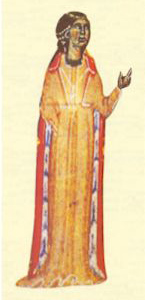
The trobairitz were Occitan female troubadours of the 12th and 13th centuries, active from around 1170 to approximately 1260. Trobairitz is both singular and plural.

Trouvère, sometimes spelled trouveur, is the Northern French form of the langue d'oc (Occitan) word trobador, the precursor of the modern French word troubadour. Trouvère refers to poet-composers who were roughly contemporary with and influenced by the trobadors, both composing and performing lyric poetry during the High Middle Ages, but while the trobadors composed and performed in Old Occitan, the trouvères used the northern dialects of France. One of the first known trouvère was Chrétien de Troyes and the trouvères continued to flourish until about 1300. Some 2130 trouvère poems have survived; of these, at least two-thirds have melodies.
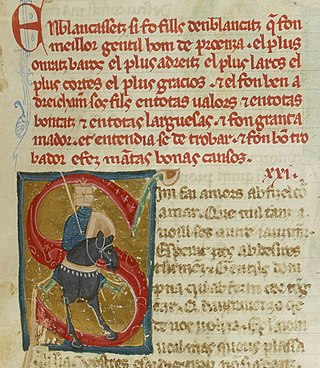
Blacasset, Blacassetz, Blacssetz, or Blachessetz was a Provençal troubadour of the noble family of the Blacas, lords of Aulps, in the Empire. He was probably a son of the troubadour Blacatz, as his vida alleges, though this has come into doubt. He was also distantly related to Charles I of Naples and Raymond Berengar IV of Provence. According to his vida, he was like his father in merit, good deeds, and munificence, and also reputed to be a good lover.
Engles, also spelled Englés, was a Navarrese jongleur and troubadour of the mid 13th century. His lone tenso survives only in fragments and is chiefly of interest to historians for its commentary on court life in Pamplona under Theobald I.
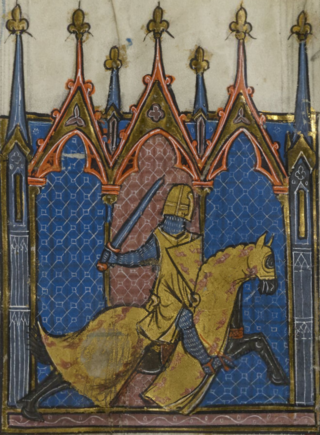
Gautier de Dargies was a trouvère from Dargies. He was one of the most prolific of the early trouvères; possibly twenty-five of his lyrics survive, twenty-two with accompanying melodies, in sixteen separate chansonniers. He was a major influence on contemporary and later trouvères, and one of the most recorded of medieval vernacular composers. Seventeen chansons courtoises can be assigned indubitably to Gautier, fifteen with music, and three more are probably his, all with music. He imported the Occitan genre of the descort into Old French and left behind three descorts with their melodies. He also participated in two jeux partis, but only one with music. His theme everywhere was courtly love.
Baudouin des Auteus was a Picard trouvère of the early thirteenth century, probably from Autheux near Doullens. According to Theodore Karp, "the two works attributed to him are both of disputed authorship."
Mahieu le Juif was an Old French trouvère. His name means "Matthew the Jew" and, if his own songs are to be believed, he was a convert from Judaism to Christianity. Only two of his songs survive, one with a melody. He has been conflated with Mahieu de Gant, but the same manuscript that contains both their works clearly distinguishes them.
Robert de Castel (d'Arras) was a trouvère active in and around Arras in the late thirteenth century. He is mentioned in the Congés of Baude Fastoul, written in 1272, which place him Arras at that date. He is the addressee of the poem Robert du Chastel, biaus sire, a jeu parti by another trouvère of Arras, Jehan Bretel, which was judged by another Artesian, Gaidifer d'Avion.
Raoul de Soissons was a French nobleman, Crusader, and trouvère. He was the second son of Raoul le Bon, Count of Soissons, and became the Sire de Coeuvres in 1232. Raoul participated in three Crusades.
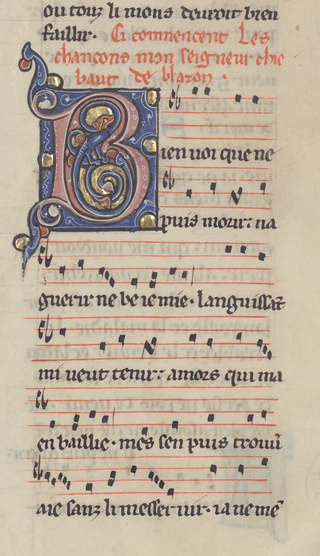
Thibaut de Blaison, Blason, or Blazon was a Poitevin nobleman, Crusader, and trouvère from a noble family with lands in Blason and Mirabeau. Eleven poems—one contested and one definitely spurious—have been ascribed to Thibaut in the chansonniers. Three further anonymous songs have also been attributed to him by Terence H. Newcombe, his modern editor.
Jehan de Braine (c. 1200 – 1240) was, jure uxoris, the Count of Mâcon and Vienne from 1224 until his death. He was a younger son of Robert II of Dreux and his second wife, Yolande de Coucy. His wife was Alix, granddaughter of William V of Mâcon. Jehan was also a trouvère and a Crusader. He followed Theobald I of Navarre to the Holy Land in the Barons' Crusade of 1239 and there died a year later. His widow, Alix, sold her counties to Louis IX of France.
Guiot de Dijon was a Burgundian trouvère. The seventeen chansons ascribed to him in the standard listing of Raynaud-Spanke are found in fifteen chansonniers, some without attribution or with conflicting attributions where they occur in multiple sources.
Jehan de Nuevile (c.1200–c.1250) was the second son of the Eustache de Nuevile, a minor nobleman with land in Neuville-Vitasse, near Arras. Jehan succeeded to the patrimony on the death of his elder brother, Eustache. He himself was dead by 1254, when his younger brother, Gilles, appears as lord at Neuville. Jehan is better known as a trouvère.
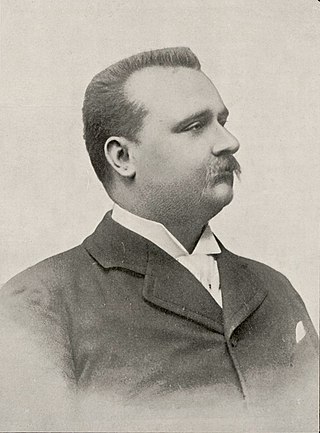
Pierre Aubry was a French musicologist who specialized in secular monophony, musical palaeography and the music of the 13th century.

The Chansonnier Cordiforme (1470s), or Chansonnier de Jean de Montchenu, is a cordiform (heart-shaped) music manuscript, Collection Henri de Rothschild MS 2973, held in the Bibliothèque Nationale, Paris, France.
François Déroche is an academic and specialist in Codicology and Palaeography, especially in relation to Quranic studies. He is a professor at the Collège de France, where he is holding "History of the Quran Text and Transmission" Chair.
Bestournés is a name given to the thirteenth-century trouvère credited with writing five pieces preserved in later thirteenth and early fourteenth century song books. The name is mostly likely a sobriquet meaning 'altered', 'changed', 'reversed', or 'metamorphosed', often 'applied to someone who, by a quirk of fate, under-went a complete reversal of fortune, either favorable or unfavorable'. As all six of these songs are preserved in the Berne Chansonnier, which was copied in Metz, and all but one of the songs are only copied there and in other Metz-copied sources, the poet-composer can probably be associated with the musical life of medieval Metz. As the name is likely a nickname or sobriquet the individual cannot be traced. Only one song, the more widely copied Or seroit mercis de saison survives with a melody in the Chansonnier du Roi and the Chansonnier de Noailles, which transmit slightly different versions of the melody.
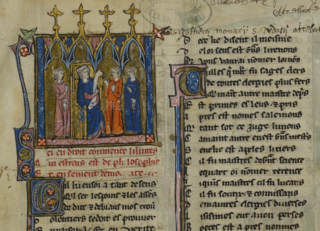
The Chansonnier d'Arras is an illuminated manuscript of the late 13th century containing a variety of religious and philosophical texts and songs in 220 folios. It is written in the Picard dialect of Old French. It is now manuscript 657 in the municipal library of Arras. In trouvère studies, it is known by the conventional siglum A.








